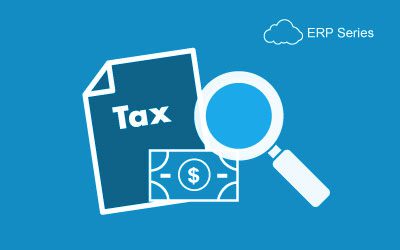Many different things go into the ERP decision and selection process. Often a necessary change for business, the path from decision to implementation is often a complicated journey for businesses, filled with risk. However, with the right planning and help, you can make a decision that benefits your business for years or even decades to come.
Financial Management Deep Dive: Breaking Down the Features of an ERP
During your path to purchase, it’s important to get to know the different features that exist in your ERP solution, understanding how they work together to create the solution you will likely use for at least five to eight years.
Following our deep dives into accounts payable, accounts receivable, cash management, and currency management, we would today like to discuss something at the top of many minds as we enter the month of March: Tax Management.
Tax Management: One Part of the Larger Financial Management Decision
With the calendar year tax filing deadline nearly upon us and your personal income taxes due shortly thereafter, there is a lot of talk about taxes right now. Knowing how challenging it is to accurately prepare and file your taxes as a business, and knowing how painful an audit is for businesses, it’s vital to stay up to date on your business taxes to avoid challenges now and in the future.
Taxes are inevitable, and whether they’re sales taxes, corporate taxes, or property taxes, your business needs to accurately track, collect, report and in most cases prepay at the Federal, State, and sometimes Local level in the US. Add to this the challenges that come from operating internationally, and you need a solution that delivers the control and visibility you need.
What is Tax Management in ERP?
In ERP, tax management streamlines and automates the tasks involved with configuring, collecting, managing, and reporting tax. Necessary for businesses to avoid costly fines or other penalties, tax management integrates with the rest of an ERP platform suite to allow businesses the opportunity to centralize information and easily generate the tax filing reports that are required of your business.
From sales tax to VAT and reverse VAT taxes, different localities have different requirements, and tax management should be able to automatically configure reporting requirements, generate summary reports, and prepare required information quickly and easily.
Why Is Tax Management Important?
Today’s businesses face new challenges in compliance. With audits already painful for businesses, the larger a business gets, the more likely that a business who underreports taxes or gets caught will face media and public scrutiny from watchdogs and others willing to bring to light a business’s failure to pay.
Added to this new challenges for ecommerce businesses in the wake of Wayfair, and today’s business needs to take proactive steps to collect and report on an increasingly complex tax landscape.
What Should You Look For?
Tax management is a necessary feature for businesses, and finding the right solution could make or break your ERP decision. With so many different jurisdictions to work with and tax codes to work under, consider the following features and benefits when comparing ERP solutions:
- Flexible Configuration: One of the hardest parts of the tax equation is the configuration process. Tax management should support sales, use, withholding, VAT, and reverse VAT taxes—anything by which you may be required to collect, report, and pay. Specify multiple rates with different start and end dates, minimum and maximum tax amounts, and calculation on each line item or the entire document amount.
- AP Integration and Automatic Offset: We’ve mentioned before how important it is that an AP solution integrates with the rest of an ERP platform; tax management included. With AP integration, you can easily prepare for tax payments, automatically calculating and generating a bill in accounts payable on a frequency you choose.
- International Readiness and Localization: While planning for and paying taxes is one thing, collecting them is another. Tax management functionality should automatically calculate taxes based on the tax zone assigned to the customer, employee, or vendor record, and the tax category assigned to inventory items.
- Drill Down and Analytics: Maintain a complete record of each tax transaction, including the originating module and transaction, the taxable amount, tax, reference number, and document type. Reconcile calculated tax with general ledger postings and drill down to the original transactions.
- Audit Trail: Maintain a complete audit trail of all tax-related transactions. The system maintains the details of all tax-related documents, including the originating module, reference numbers, and date of the record. Adjustment can only be made through auditable transactions.
Part of the larger Financial Management Suite within Acumatica, Tax Management ensures you stay compliant and reduce any risk that comes about when collecting or paying taxes.
Acumatica Financial Management: Delivering Tax Management and Much More
Finding a solution that is user-friendly and functional is a key decision process in the ERP evaluation stage. Acumatica delivers a full suite of integrated business management applications unlike any other ERP solution on the market today. Offering a wide range of products for unique industry needs, Acumatica ERP features a strong cash management application for businesses who need a flexible, adaptable, and robust ERP solution that will grow with them.
Learn more about Acumatica Financial Management, your path to making an ERP decision, and contact us to learn how we can help you.


